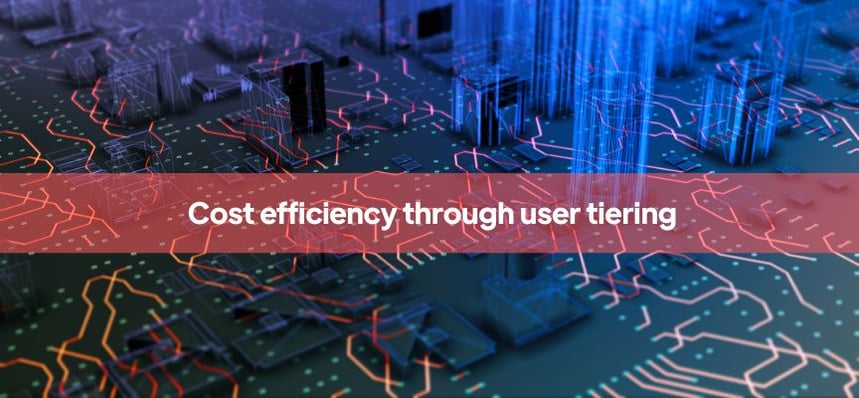One potent strategy to refine business services while also lowering operational costs involves aligning user tiers with infrastructure costs. This tactic involves segmenting users based on their tiers and allocating resources accordingly. In fact, a 2019 study from McKinsey revealed that companies effectively utilizing customer segmentation saw a 10% increase in profit margins. But how can this be done efficiently? Let's delve deeper.
The power of user segmentation
Each user is unique, yet they often share common characteristics that can categorize them into tiers. These include usage patterns, expectations, and willingness to pay. A 2018 Gartner report revealed that businesses effectively segmenting their user base experienced a 15% improvement in service delivery and a significant decrease in operational expenses.
Consider Netflix, which deploys segmentation based on user behavior and content preferences to provide personalized content recommendations. This not only improves the user experience but also ensures efficient use of their infrastructure resources by understanding peak usage times and user habits.
The goal is dual-fold: to deliver an optimal level of service to each user tier and to correlate the cost of the allocated infrastructure with the revenue each segment generates. This approach avoids resource wastage on low-value users while ensuring high-value users receive the service they require.
Implementing user tiering strategies
In the tech industry, implementing user tiering strategies can mean the difference between a business that thrives and one that struggles to meet its operational and financial goals. The following steps can provide a roadmap for implementing these strategies effectively.
1. Understanding user behavior
The first step towards effective segmentation is understanding user behavior. Through scrutinizing user data, patterns emerge, like service usage, frequency of interaction, and engagement levels. A study by Adobe highlighted that companies using data-driven marketing strategies were six times more likely to be profitable year-over-year.
For example, Spotify uses data-driven strategies to understand user behavior, segmenting them into free, freemium, and premium users. These insights guide infrastructure resource allocation, ensuring optimal service delivery and resource efficiency.
2. Defining user tiers
After understanding user behavior, you can define user tiers accordingly. The number of tiers and their definitions depend on your business model and customer base. For instance, tiers could be based on subscription level (free, premium), usage level (light, moderate, heavy), or value to the business (low, medium, high).
3. Aligning tiers with infrastructure
Following the definition of user tiers, allocate resources to meet the characteristics and needs of each. High-value or heavy usage tiers may require more robust resources, while light usage or low-value tiers could be adequately served with less. This ensures every user receives the service they require without the company bearing unnecessary costs.
Constructing a cost-efficient infrastructure
After user tiers are established, businesses can take steps to construct a cost-efficient infrastructure. Here are a few strategies:
1. Dynamic resource allocation
Cloud computing has made dynamic resource allocation easier than ever. A 2022 report from RightScale showed companies adopting cloud strategies could reduce wastage by up to 35%. If companies leverage cloud services efficiently, they can scale their resources up or down based on user demand, ensuring high-demand periods are met and resources aren't wasted during low-demand periods.
2. Infrastructure as a Service (IaaS)
IaaS providers offer scalable and adjustable resources on a pay-as-you-go basis, which can be a cost-effective solution for businesses. With IaaS, you can tailor infrastructure costs to fit your needs, paying for what you use.
Moreover, the main goal of changing cloud infrastructure should be to cut costs by getting rid of cloud infrastructure that isn't needed, is over-engineered, or isn't being used. Instead of just repeating service levels, using cloud infrastructure to avoid disruptions in the supply chain, and updating old infrastructure, the goal should be to make businesses more resilient. According to Gartner, by 2027, 65% of application workloads will be ready or well-suited for cloud delivery. This is a big jump from 2022, when only 45% of application workloads were ready or well-suited for cloud delivery.
3. Performance monitoring
Implementing robust performance monitoring is crucial. Identifying potential bottlenecks or inefficiencies in your infrastructure, through regular audits, and adjustments, ensures your system remains optimized for cost and performance.
Shopify leverages Kubernetes for efficient resource management, enabling the company to handle increased demand during high-traffic events like Black Friday.
Harnessing kubernetes with Kubeark
Kubernetes, a powerful open-source platform for managing containerized workloads and services, can also play a critical role in aligning user tiers with infrastructure costs. With its extension, Kubeark, companies can effectively orchestrate their infrastructure to align with user needs.
Kubeark offers a scalable, flexible, and cost-effective way to manage your applications and services. Its ability to handle containerized applications means businesses can define their infrastructure based on user tiers, effectively and efficiently using resources based on the demand from each tier.
Kubeark's role in dynamic resource allocation
Kubeark’s auto-scaling features facilitate dynamic resource allocation. With its built-in horizontal and vertical auto-scaling capabilities, Kubeark can automatically scale your applications up or down, depending on real-time demands. This means during periods of high demand, Kubeark can automatically deploy more resources, ensuring that your high-value or heavy usage tiers are sufficiently catered to. During periods of low demand, it scales back, ensuring that resources aren't wasted.
Implementing IaaS with Kubeark
Kubeark can be integrated seamlessly with various Infrastructure as a Service (IaaS) providers. This means that you can leverage Kubeark's capabilities to manage your resources across multiple cloud providers efficiently. Its multi-cloud compatibility enables businesses to avoid vendor lock-in, select services based on pricing or features, and have a robust disaster recovery strategy.
Performance monitoring with Kubeark
Kubeark can help with performance monitoring and resource optimization. Through its integration with monitoring tools, businesses can gain real-time insights into resource utilization, potential bottlenecks, and system performance. These data-driven insights can help businesses optimize their resource allocation, making adjustments where necessary to maintain a high-performing, cost-efficient infrastructure.
Aligning user tiers with infrastructure costs offers businesses an effective way to provide superior service while managing operational costs. Through understanding user behavior, defining user tiers, and allocating resources effectively, businesses can create a more efficient and cost-effective operation. Furthermore, implementing strategies like dynamic resource allocation, Infrastructure as a Service (IaaS), performance monitoring, and leveraging platforms like Kubeark, companies can maintain a cost-efficient, high-performing infrastructure. Put our capabilities to the test. Book a personalized demo!

